Farin G. Curves and Surfaces for CAGD. A Practical Guide
Подождите немного. Документ загружается.

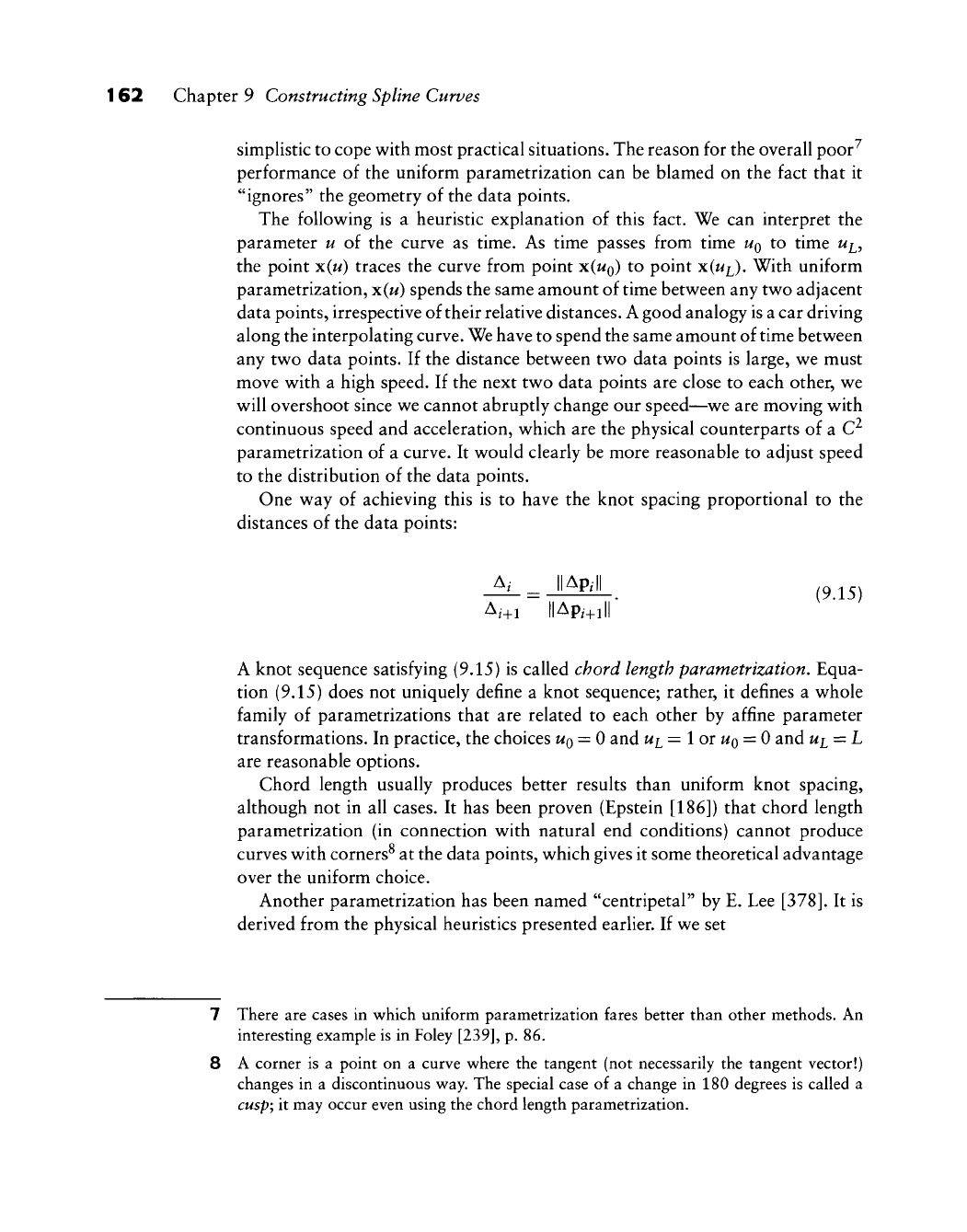
162 Chapter 9 Constructing Spline Curves
simplistic to cope with most practical situations. The reason for the overall poor^
performance of the uniform parametrization can be blamed on the fact that it
"ignores" the geometry of the data points.
The following is a heuristic explanation of this fact. We can interpret the
parameter u of the curve as time. As time passes from time
UQ
to time u^^
the point x(w) traces the curve from point x(wo) ^^ point x(wj^). With uniform
parametrization, x(w) spends the same amount of time between any two adjacent
data points, irrespective of their relative distances. A good analogy is a car driving
along the interpolating curve. We have to spend the same amount of time between
any two data points. If the distance between two data points is large, we must
move with a high speed. If the next two data points are close to each other, we
will overshoot since we cannot abruptly change our speed—we are moving with
continuous speed and acceleration, which are the physical counterparts of a C^
parametrization of a curve. It would clearly be more reasonable to adjust speed
to the distribution of the data points.
One way of achieving this is to have the knot spacing proportional to the
distances of the data points:
A. _ IIAp.ll (9^^^)
A,+i ||Ap,-+i||
A knot sequence satisfying (9.15) is called chord length parametrization. Equa-
tion (9.15) does not uniquely define a knot sequence; rather, it defines a whole
family of parametrizations that are related to each other by affine parameter
transformations. In practice, the choices
UQ
= 0 and
ui^
=
lor:uQ^
= 0 and ui = L
are reasonable options.
Chord length usually produces better results than uniform knot spacing,
although not in all cases. It has been proven (Epstein [186]) that chord length
parametrization (in connection with natural end conditions) cannot produce
curves with corners^ at the data points, which gives it some theoretical advantage
over the uniform choice.
Another parametrization has been named "centripetal" by E. Lee
[378].
It is
derived from the physical heuristics presented earlier. If we set
There are cases in which uniform parametrization fares better than other methods. An
interesting example is in Foley
[239],
p. 86.
A corner is a point on a curve where the tangent (not necessarily the tangent vector!)
changes in a discontinuous way. The special case of a change in 180 degrees is called a
cusp;
it may occur even using the chord length parametrization.
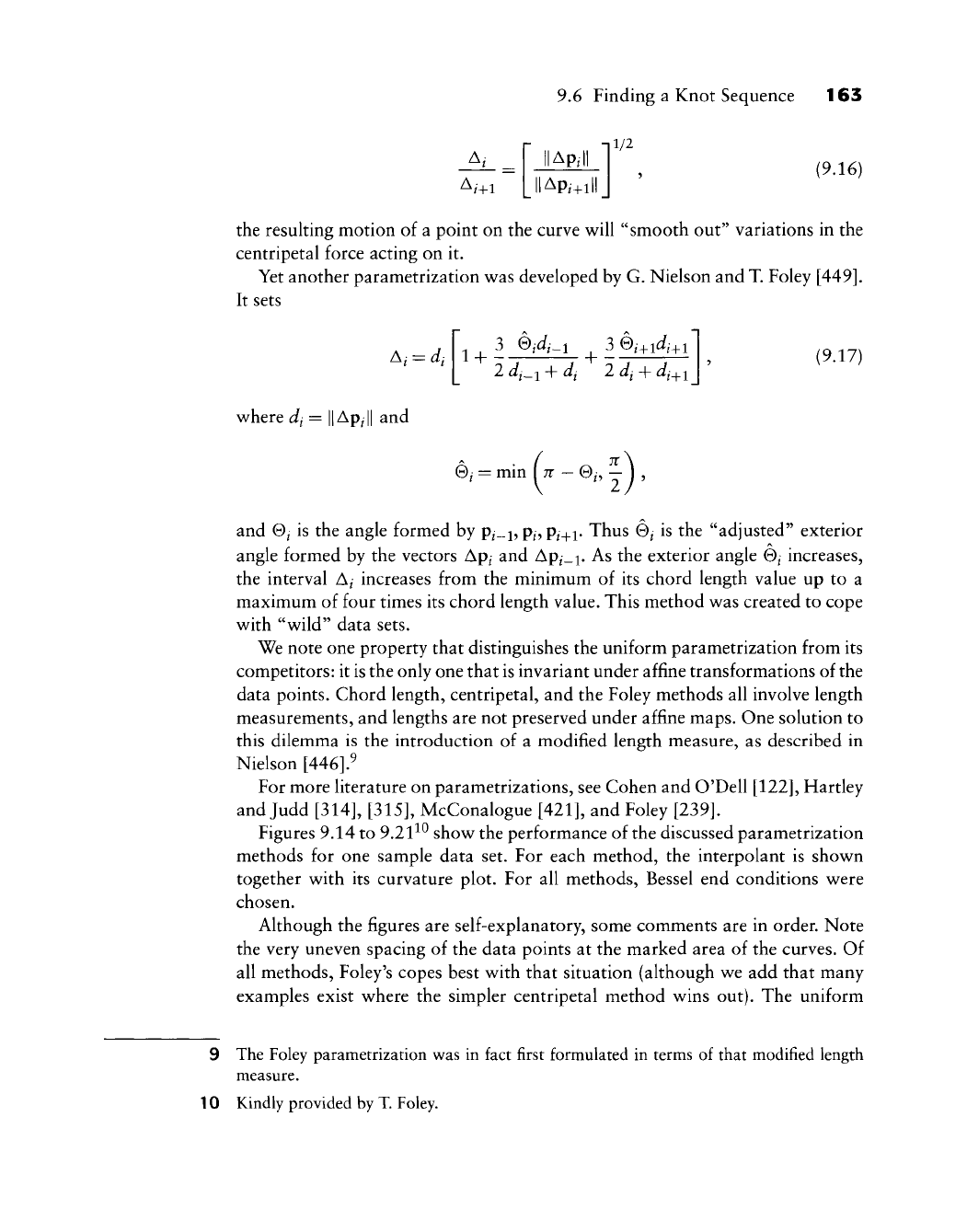
A,+i
9.6 Finding a Knot Sequence 163
,1/2
lApil'
|Api+ill
(9.16)
the resulting motion of a point on the curve will "smooth out" variations in the
centripetal force acting on it.
Yet another parametrization v^as developed by G. Nielson and T. Foley
[449].
It sets
A,-
= di
where dj =
||
Ap^||
and
^ 3 Q/4-1 3 0^+i4fl
2 di_i + dj 2 dj -h
di_^i
(9.17)
0; = min
(.-e,.|).
and 0/ is the angle formed by p/-i, P/, p^+i- Thus 0^ is the "adjusted" exterior
angle formed by the vectors Ap/ and
Ap^.j.
As the exterior angle 0^ increases,
the interval A^ increases from the minimum of its chord length value up to a
maximum of four times its chord length value. This method was created to cope
with "wild" data sets.
We note one property that distinguishes the uniform parametrization from its
competitors: it is the only one that is invariant under affine transformations of the
data points. Chord length, centripetal, and the Foley methods all involve length
measurements, and lengths are not preserved under affine maps. One solution to
this dilemma is the introduction of a modified length measure, as described in
Nielson
[446].^
For more literature on parametrizations, see Cohen and O'Dell
[122],
Hartley
and Judd
[314], [315],
McConalogue
[421],
and Foley
[239].
Figures 9.14 to
9.21^^
show the performance of the discussed parametrization
methods for one sample data set. For each method, the interpolant is shown
together with its curvature plot. For all methods, Bessel end conditions were
chosen.
Although the figures are self-explanatory, some comments are in order. Note
the very uneven spacing of the data points at the marked area of the curves. Of
all methods, Foley's copes best with that situation (although we add that many
examples exist where the simpler centripetal method wins out). The uniform
9 The Foley parametrization was in fact first formulated in terms of that modified length
measure.
10 Kindly provided by
T.
Foley.
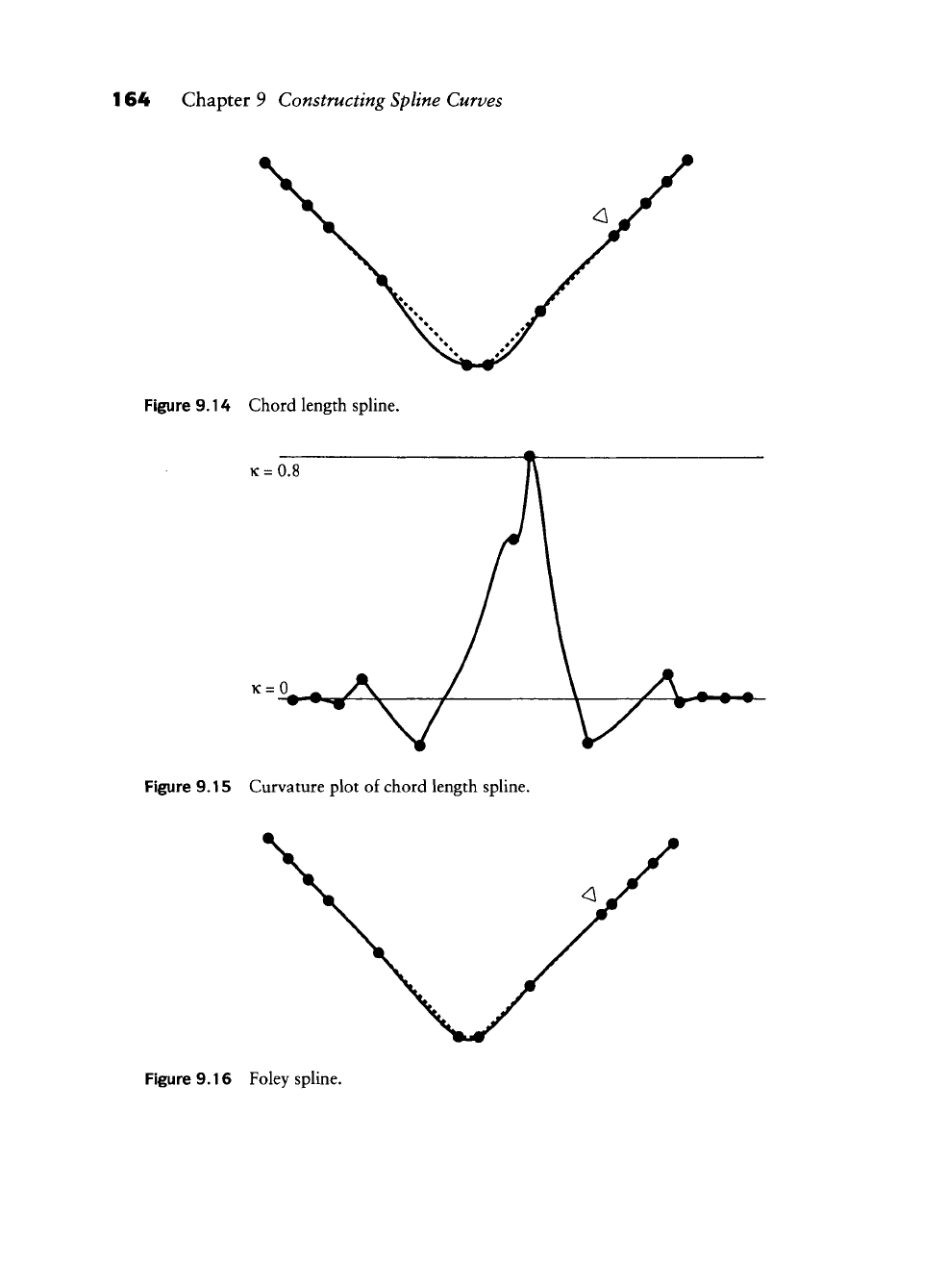
164 Chapter 9 Constructing Spline Curves
Figure 9.14 Chord length sphne.
K =
0.8
Figure 9.15 Curvature plot of chord length spUne.
Figure 9.16 Foley spline.
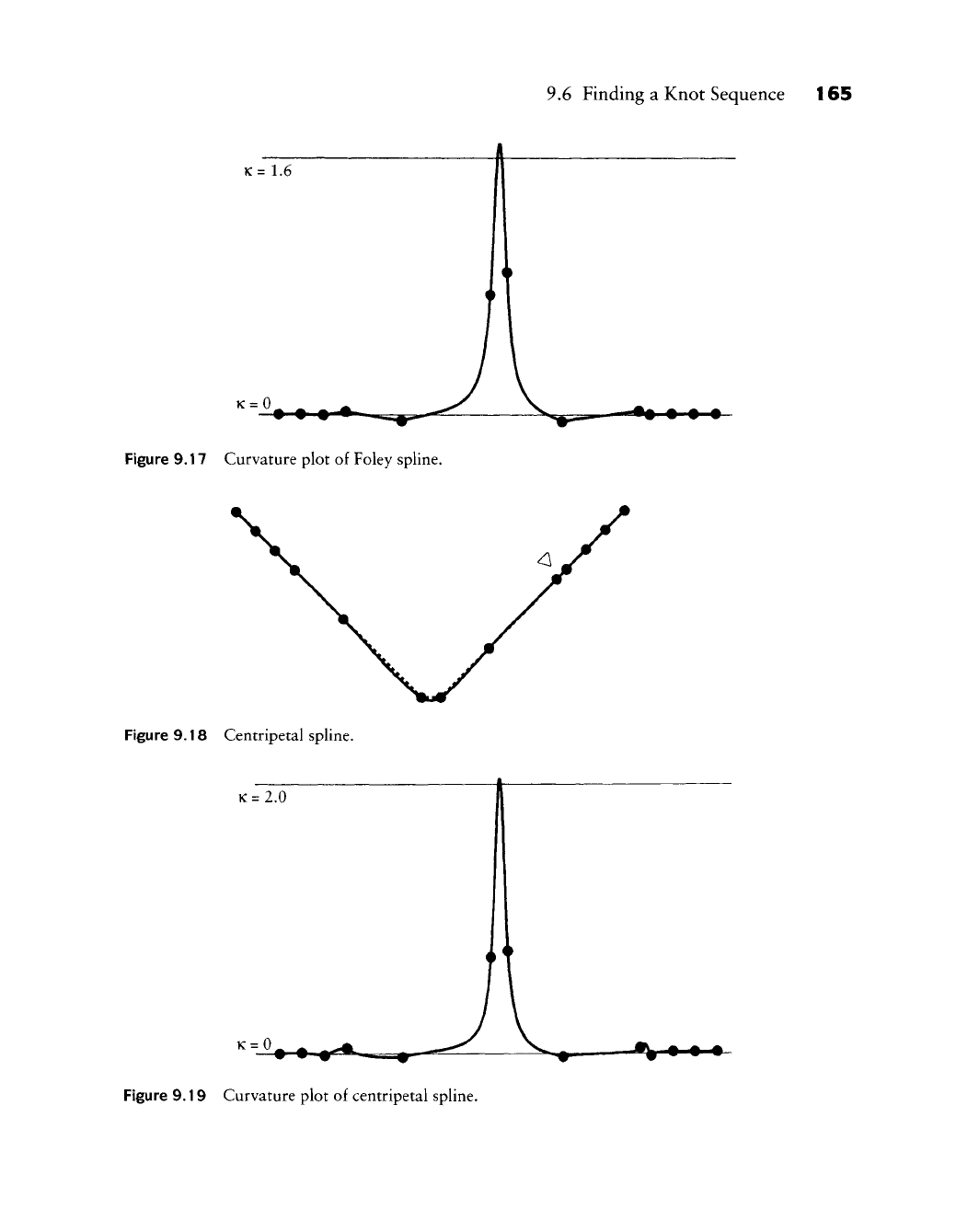
9.6 Finding a Knot Sequence 165
K= 1.6
K=0
Figure 9.17 Curvature plot of Foley spline.
Figure 9.18 Centripetal spline.
K =
2.0
K=0
Figure 9.19 Curvature plot of centripetal spline.
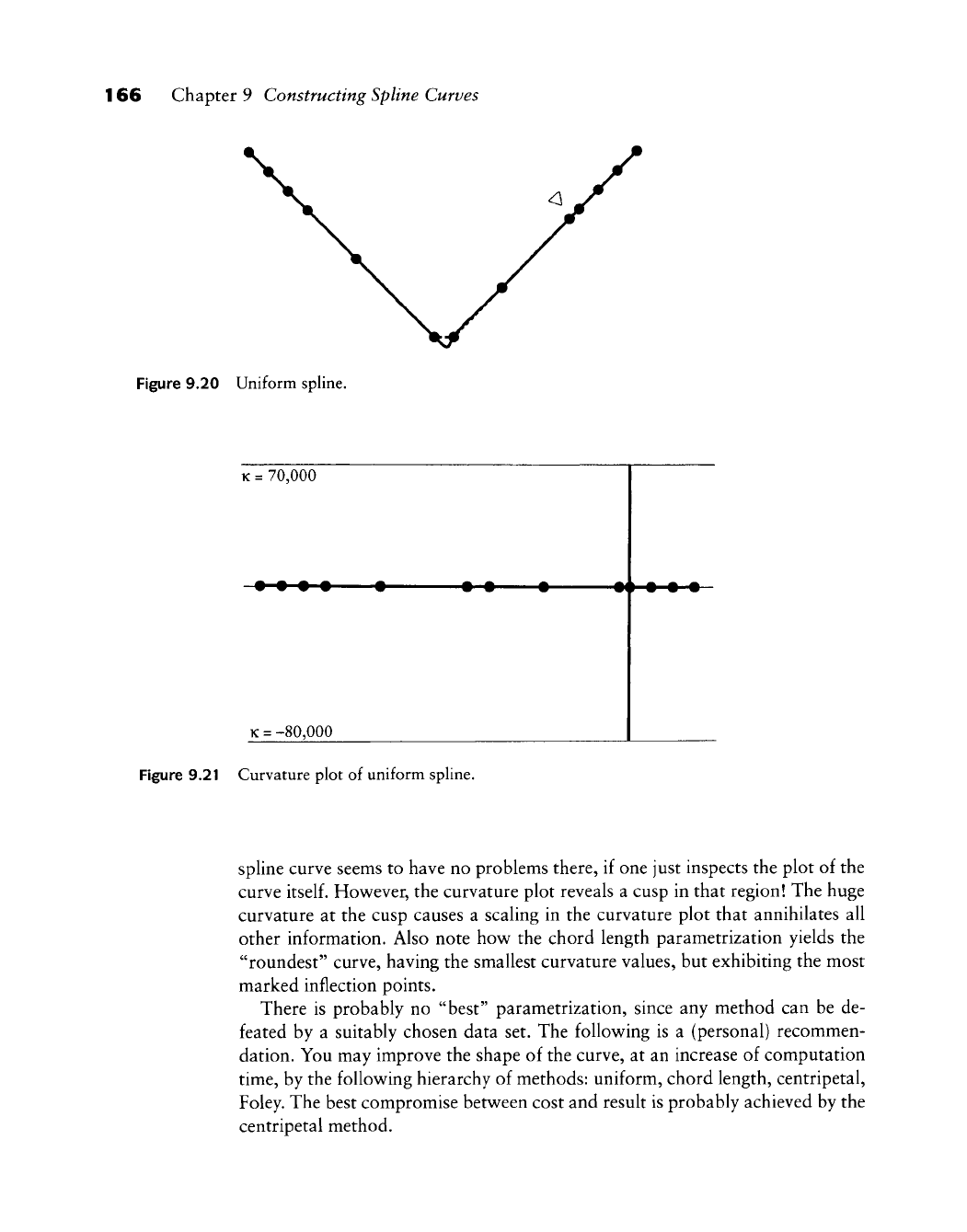
166 Chapter 9 Constructing Spline Curves
Figure 9.20 Uniform spline.
K =
70,000
• • • • •
• • • •• • • •
K =
-80,000
Figure 9.21 Curvature plot of uniform spline.
Spline curve seems to have no problems there, if one just inspects the plot of the
curve
itself.
However, the curvature plot reveals a cusp in that region! The huge
curvature at the cusp causes a scaling in the curvature plot that annihilates all
other information. Also note hov^ the chord length parametrization yields the
"roundest" curve, having the smallest curvature values, but exhibiting the most
marked inflection points.
There is probably no "best" parametrization, since any method can be de-
feated by a suitably chosen data set. The foUov^ing is a (personal) recommen-
dation. You may improve the shape of the curve, at an increase of computation
time,
by the follov^ing hierarchy of methods: uniform, chord length, centripetal,
Foley. The best compromise betv^een cost and result is probably achieved by the
centripetal method.

9.7 The Minimum Property 167
9.7 The Minimum Property
In the early days of design, say, ship design in the 1800s, the problem had to be
handled of how to draw (manually) a smooth curve through a given set of points.
One way to obtain a solution was the following: place metal weights (called
ducks) at the data points, and then pass a thin, elastic wooden beam (called a
spline) between the ducks. The resulting curve is always very smooth and usually
aesthetically pleasing. The same principle is used today when an appropriate
design program is not available or for manual verification of a computer result;
see Figure 9.22.
The plastic or wooden beam assumes a position that minimizes its strain
energy. The mathematical model of the beam is a curve s, and its strain energy
£ is given by
h
(s)fds,
where
/c
denotes the curvature of the curve. The curvature of most curves involves
integrals and square roots and is cumbersome to handle; therefore, one often
approximates the preceding integral with a simpler one:
-/
s{u)
du.
(9.18)
Note that E is a vector; it is obtained by performing the integration on each
component of s.
Equation (9.18) is more directly motivated by the following example: when
an airplane is scheduled to fly from A to B, it will have to fly over a number of
intermediate "way points." The amount of fuel used by an airplane is mostly af-
fected by its acceleration, which is essentially equivalent to the second derivative
j^
Figure 9.22 Spline interpolation: a plastic beam, the spline, is forced to pass through data points,
marked by metal weights, the ducks.
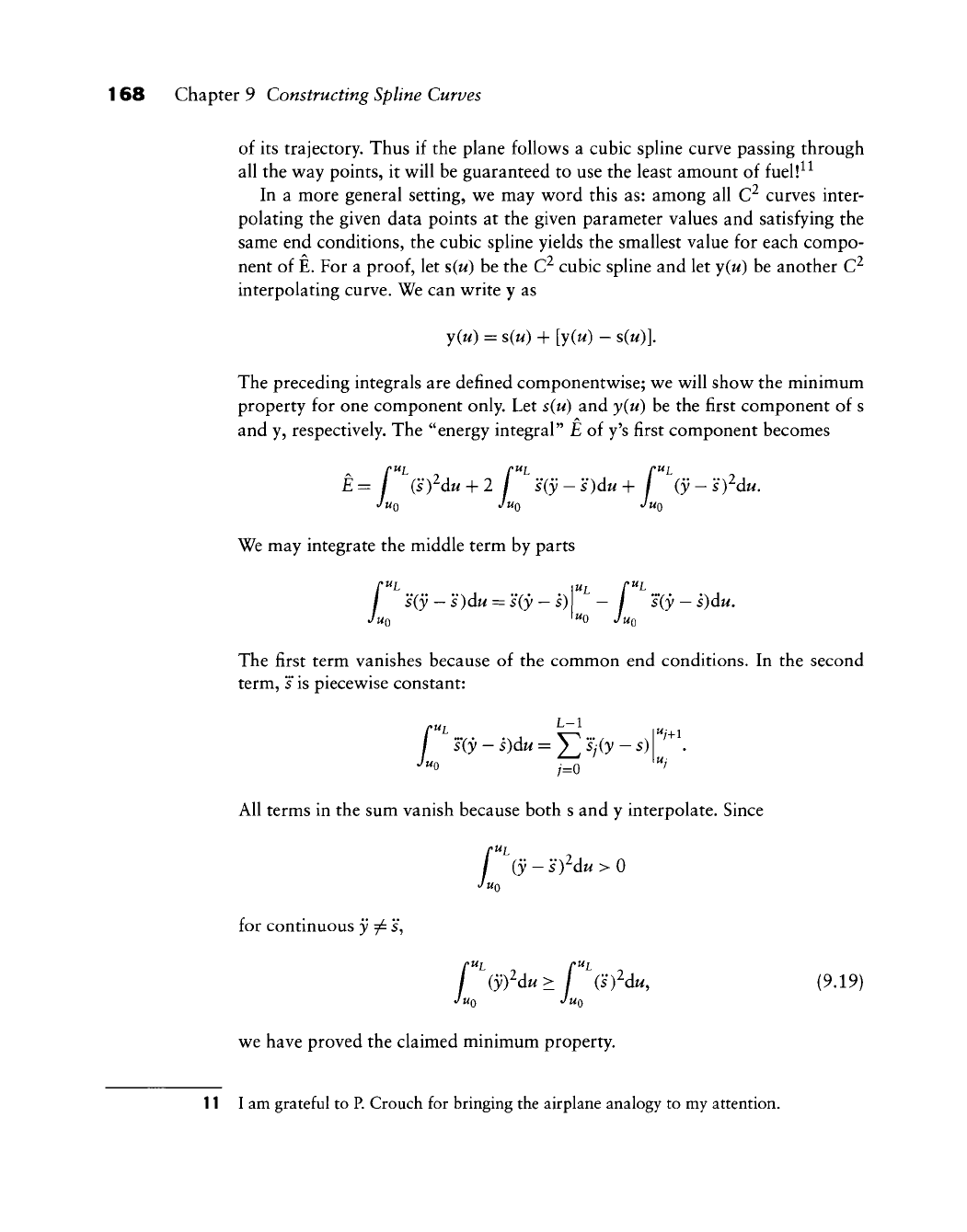
168 Chapter 9 Constructing Spline Curves
of its trajectory. Thus if the plane follows a cubic spline curve passing through
all the way points, it will be guaranteed to use the least amount offuell^i
In a more general setting, we may word this as: among all C^ curves inter-
polating the given data points at the given parameter values and satisfying the
same end conditions, the cubic spline yields the smallest value for each compo-
nent of E. For a
proof,
let s{u) be the C^ cubic spline and let y{u) be another C^
interpolating curve. We can write y as
y{u) = s(u) + [y(u) - s(u)l
The preceding integrals are defined componentwise; we will show the minimum
property for one component only. Let s(u) and y(u) be the first component of s
and y, respectively. The "energy integral" E of y's first component becomes
pUi pUi pUi
E= (sfdu + 2 / s(y - s)du + / (y - sfdu.
JUQ JUQ JUQ
We may integrate the middle term by parts
I s(y
—
s)du = s(y
—
s) — / s\y
—
s)du,
Jua '"0 Juo
The first term vanishes because of the common end conditions. In the second
term, s is piecewise constant:
/
UT ^-1
"s{y
- s)du = ^ Sj(y - s)
"0 /=o
*/
All terms in the sum vanish because both s and y interpolate. Since
/ {y - 'iydu > 0
JUQ
for continuous y ^ s,
f ^(yfdu
>
f ^(sfdu, (9.19)
JUQ JUQ
we have proved the claimed minimum property.
11 I am grateful to
P.
Crouch for bringing the airplane analogy to my attention.

9.8 C^ Piecewise Cubic Interpolation 169
The minimum property of splines has spurred substantial research activity.
The replacement of the actual strain energy measure £ by E is motivated by the
desire for mathematical simplicity. The curvature of a curve is given by
, , IIXAXII
llxlP
But we need ||x|| ^ 1 in order for ||x|| to be a good approximation to /c. This
means, how^ever, that the curve must be parametrized according to arc length;
see (10.7). This assumption is not very realistic for cubic splines in a design
environment; see Problems.
While the classical spline curve merely minimizes an approximation to (9.18),
methods have been developed that produce interpolants that minimize the true
energy (9.18), see
[425],
[99]. Moreton and Sequin have suggested to minimize
the functional f[K\t)f-dt instead; see
[431].
9.8 C^ Piecewise Cubic Interpolation
Spline curves come in the B-spline form, but they may also be described as
piecew^ise Bezier curves. We now^ consider that approach, applied to piecewise
cubic interpolation. First, v^e try to solve the foUow^ing problem:
Given: Data points
XQ,
...,
x^^
and tangent directions
IQ,
...,
1^
at those data
points; see Figure 9.23.
Find:
A C^ piecewise cubic polynomial that passes through the given data
points and is tangent to the given tangent directions there.
It is important to note that we only have tangent directions^ that is, we have
no vectors with a prescribed length since our problem statement did not involve
Figure 9.23 C^ piecewise cubics: example data set.
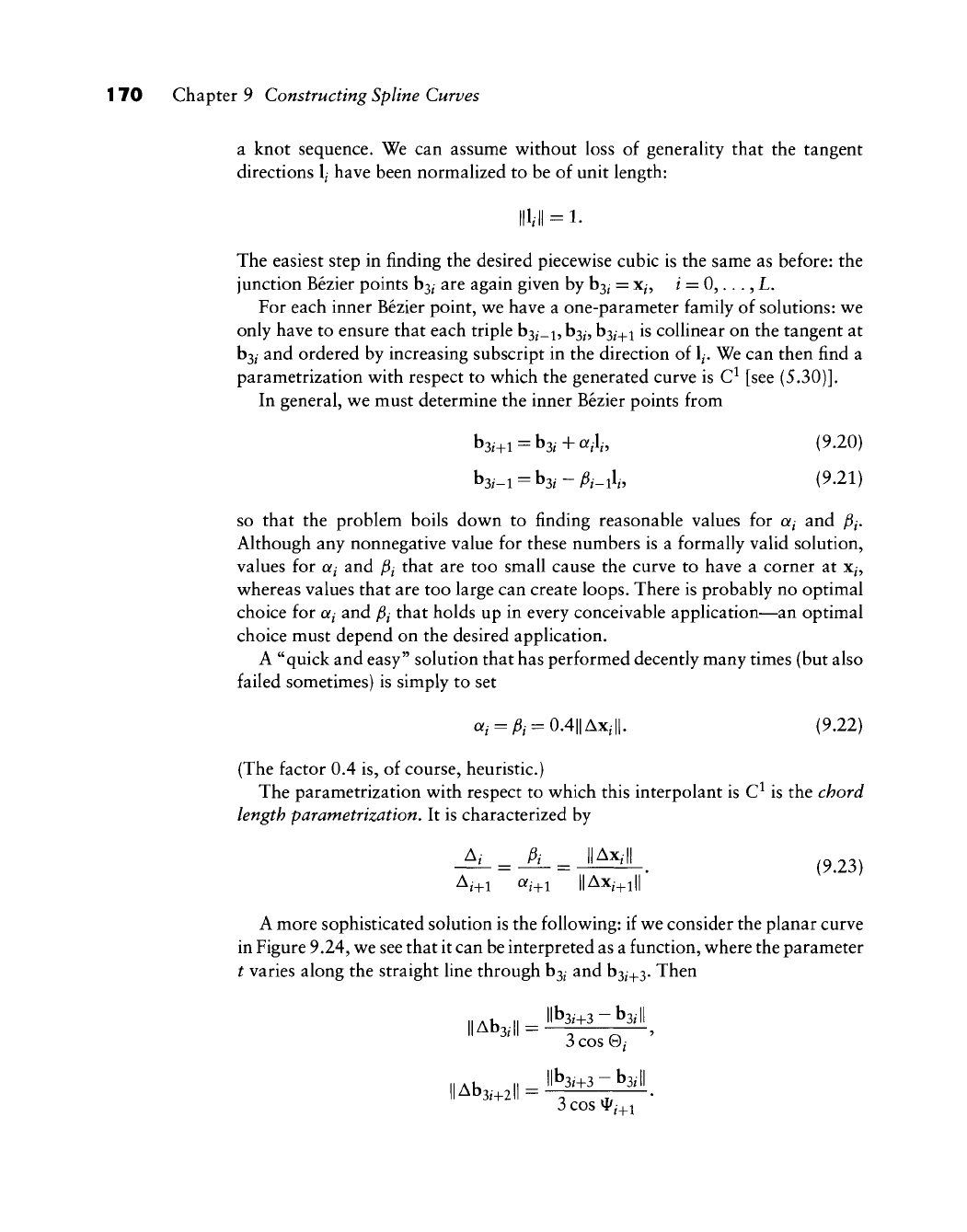
170 Chapter 9 Constructing Spline Curves
a knot sequence. We can assume without loss of generahty that the tangent
directions
1^
have been normahzed to be of unit length;
111;
II
=
1.
The easiest step in finding the desired piecewise cubic is the same as before: the
junction Bezier points
hi^i
are again given by b3/ = X/, / = 0,..., L.
For each inner Bezier point, we have a one-parameter family of solutions: we
only have to ensure that each triple h^i-i-,
h^^i^
^^i^^i
is coUinear on the tangent at
hi^i
and ordered by increasing subscript in the direction of
1^.
We can then find a
parametrization with respect to which the generated curve is C^ [see (5.30)].
In general, we must determine the inner Bezier points from
b3/+i = b3,+a,l„ (9.20)
b3.-i = b3,-^,_il„ (9.21)
so that the problem boils down to finding reasonable values for oti and )6^.
Although any nonnegative value for these numbers is a formally valid solution,
values for a^ and Pi that are too small cause the curve to have a corner at x^,
whereas values that are too large can create loops. There is probably no optimal
choice for of/ and Pi that holds up in every conceivable application—an optimal
choice must depend on the desired application.
A "quick and easy" solution that has performed decently many times (but also
failed sometimes) is simply to set
a, = ft = 0.4||Ax,||. (9.22)
(The factor 0.4 is, of course, heuristic.)
The parametrization with respect to which this interpolant is C^ is the chord
length parametrization. It is characterized by
A, _ ft _ ||Ax,|| ^^^^^^
A,+i a,+i ||Ax,+i||
A more sophisticated solution is the following: if we consider the planar curve
in Figure 9.24, we see that it can be interpreted as a function, where the parameter
t varies along the straight line through
b3^
and
b3^_^3.
Then
l|Ab3,||-'l''^'>^-^^'l'
3 cos 0/
3
COS
^ij^i
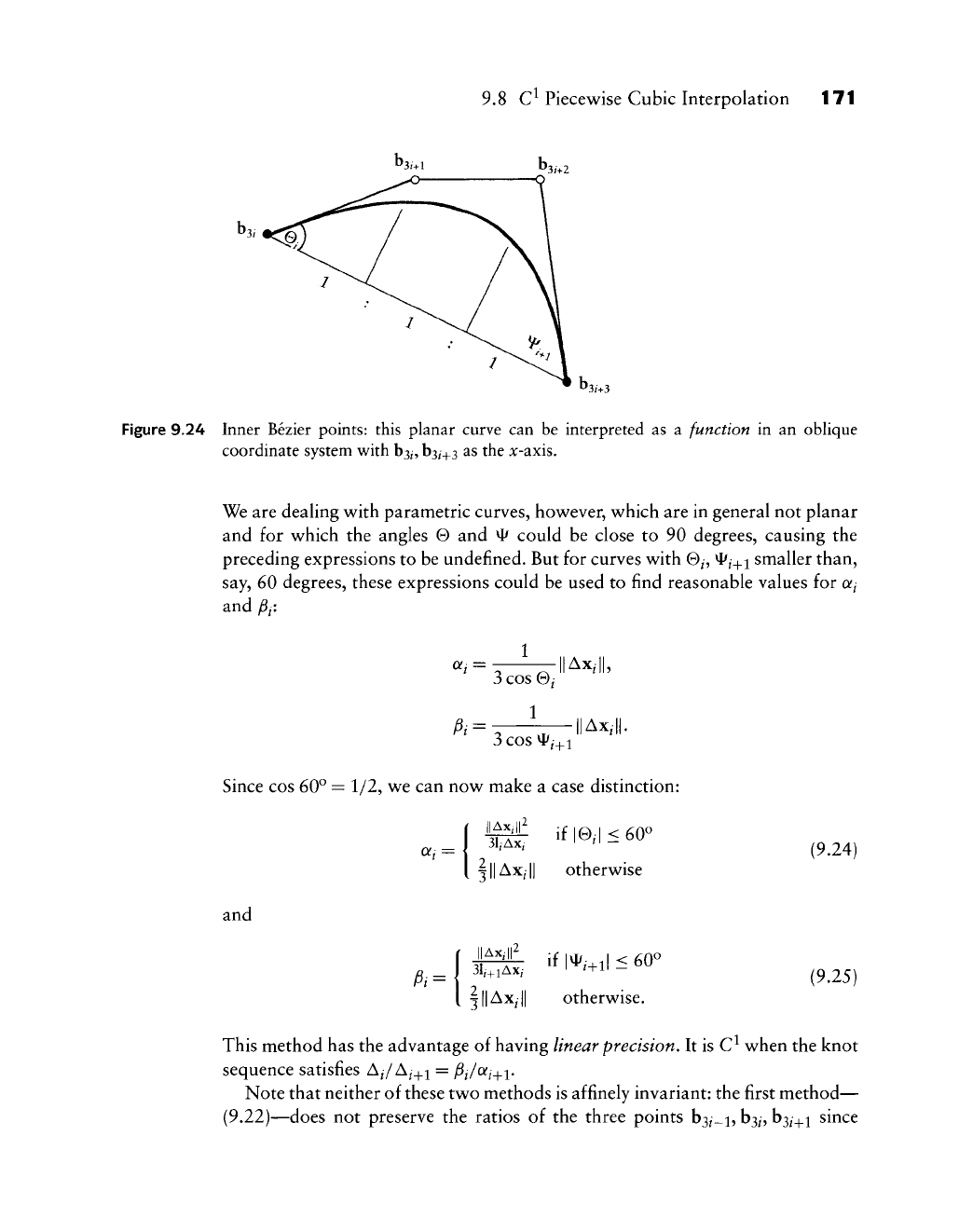
9.8 C^ Piecewise Cubic Interpolation 171
Figure 9.24 Inner Bezier points: this planar curve can be interpreted as a function in an oblique
coordinate system with
b3/,
b3/+3
as the x-axis.
We are dealing with parametric curves, however, which are in general not planar
and for which the angles 0 and ^ could be close to 90 degrees, causing the
preceding expressions to be undefined. But for curves with 0^, ^^_^i smaller than,
say, 60 degrees, these expressions could be used to find reasonable values for of/
and ^i'.
1
P^
3 cos 0/
1
lAX;
I
Ax,
I
3 cos ^ij^\
Since cos 60^ = 1/2, we can now make a case distinction:
iiAx,r
31/Ax,
if |0,| < 60^
|||Ax;|| Otherwise
(9.24)
and
II
Ax,
I
^,=
131;;^
if|*ml<60°
lAX;
Otherwise.
(9.25)
This method has the advantage of having linear precision. It is C^ when the knot
sequence satisfies Aj/Aj^i = ^i/oti^\.
Note that neither of these two methods is affinely invariant: the first method—
(9.22)—does not preserve the ratios of the three points b3,_i, b3p b3/_^i since
